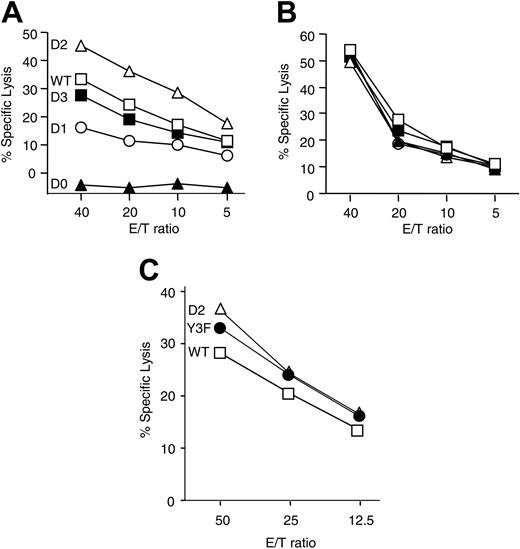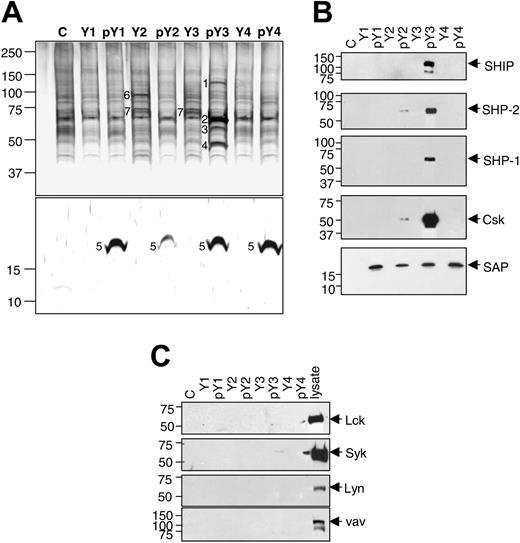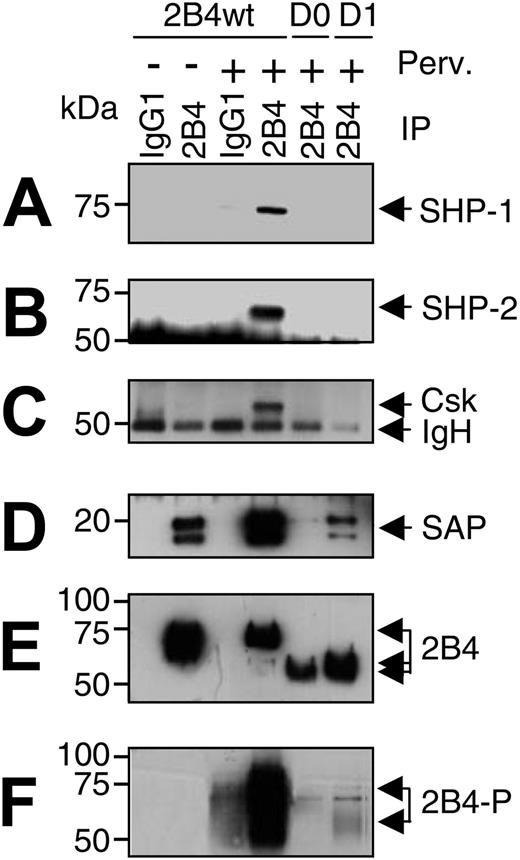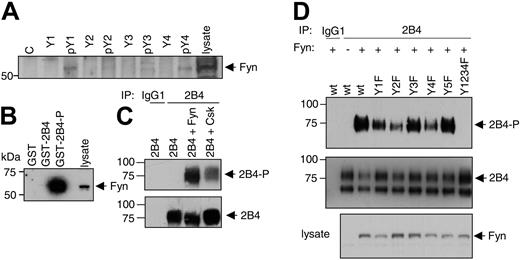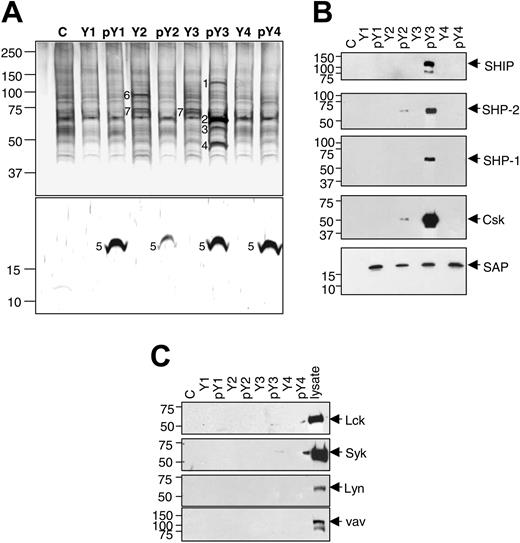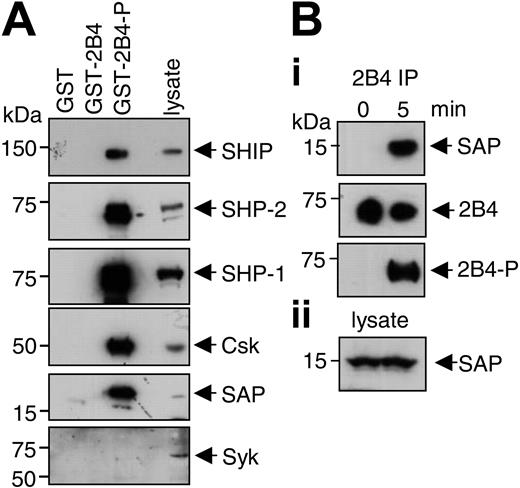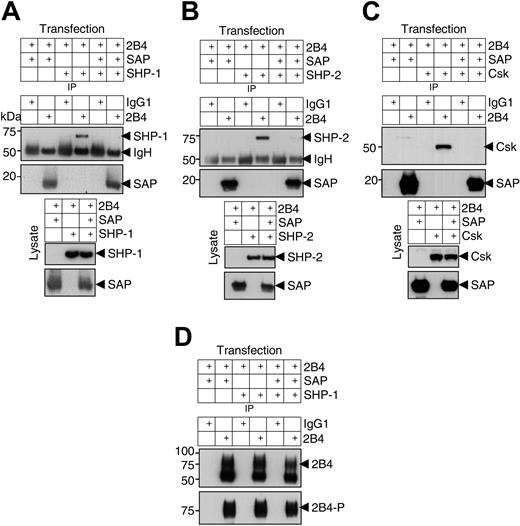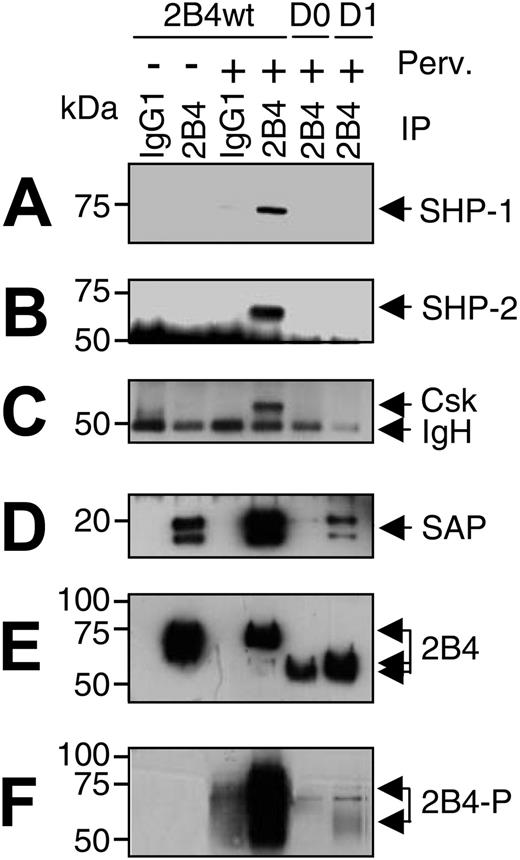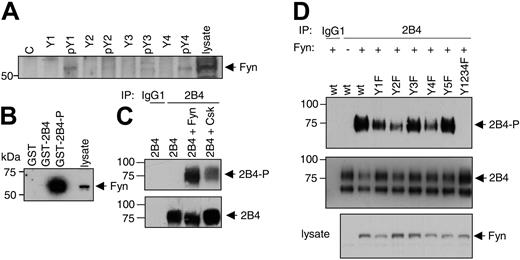Abstract
Triggering of 2B4 (CD244) can induce natural killer (NK)-cell activation, costimulation, or even inhibition of NK-cell activity. Here, we investigate the molecular basis for the different signals generated by 2B4. We show that the first immunoreceptor tyrosine-based switch motif (ITSM) within the cytoplasmic tail of 2B4 is sufficient for 2B4-mediated NK-cell activation, whereas the third ITSM can negatively influence 2B4 signaling. We further identify signaling molecules that associate with 2B4. Signaling lymphocyte activation molecule-associated protein (SAP) can bind to all 4 ITSMs of 2B4 in a phosphorylation-dependent manner. The phosphorylated third ITSM can additionally recruit the phosphatases SHP-1, SHP-2, SHIP, and the inhibitory kinase Csk. SAP acts as an inhibitor of interactions between 2B4 and these negative regulatory molecules, explaining how 2B4 inhibits NK-cell activation in the absence of functional SAP, as occurs in cells from patients with X-linked lymphoproliferative syndrome (XLP). Recently, another function for SAP was proposed: SAP can recruit the kinase Fyn to the SLAM (CD150) immune receptor. We now show that Fyn can also associate with phosphorylated 2B4. Finally, we demonstrate that Fyn and Csk can both phosphorylate 2B4, suggesting a possible mechanism of 2B4 phosphorylation. (Blood. 2005;105:4722-4729)
Introduction
The activity of natural killer (NK) cells is regulated by a multitude of different surface receptors.1 Depending on their function they can be divided roughly into activating and inhibiting receptors. In human NK cells inhibiting receptors are represented by members of the KIR (killer cell immunoglobulin-like receptor) family and by the CD94/NKG2 heterodimer.2 Inhibiting receptors recognize self-major histocompatibility complex (MHC) class I and thereby protect normal cells from NK-cell attack.3 Many activating NK-cell receptors have been discovered only recently and include NKp30, NKp44, NKp46, NKp80, NKG2D, DNAM-1, 2B4, NTB-A, and CS1 (CRACC).4 2B4 binds to CD48, which is widely expressed in the hematopoietic system.5,6 NTB-A and CS1 (CRACC) are homophilic,7-9 and NKG2D recognizes several different ligands, some of which are inducible by cellular stress.10 In most cases, however, the ligands or structures recognized by activating NK-cell receptors remain unknown.
Signals by activating and inhibiting receptors are finely balanced to ensure the tolerance of NK cells toward normal cells.11 This balance can be disturbed by a reduction of the negative signals or by an enhancement of positive signals, both leading to the activation of NK cells. A loss of negative signal is usually observed when target cells lose MHC class I expression, for example, during viral infection or transformation, and thereby become sensitive to NK-cell attack.12 Recently, it became clear that the induced expression of ligands for activating NK-cell receptors on target cells with normal MHC class I expression is also sufficient to lead to NK-cell activation.13 This underscores the fine balance of positive and negative signals that regulate NK-cell activity.
2B4 was first identified as an activating NK-cell receptor.14 In humans 2B4 is expressed on all NK cells, γδ T cells, monocytes, basophils, and on a subset of CD8+ T cells.15-17 On engagement 2B4 can stimulate NK-cell cytotoxicity, production of interferon γ, and granule exocytosis.15,16,18 However, depending on the cell type and on the stage of differentiation, engagement of 2B4 can have different outcomes. In addition to being an activating receptor, 2B4 can also enhance signals by other NK receptors such as NKp30 and NKp46,19 thereby acting as a costimulator. At early stages of NK-cell differentiation 2B4 can even function as an inhibitory receptor,20 possibly ensuring the self-tolerance of developing NK cells. In T cells, triggering of 2B4 does not lead to T-cell activation by itself,16 but it can augment antigen-specific T-cell cytotoxicity.21 The CD48-2B4 interaction is also important for the regulation of CD8+ T-cell proliferation.22
2B4 belongs to the signaling lymphocytic activation molecule (SLAM)-related receptors (SRRs)23 and contains 4 immunoreceptor tyrosine-based switch motifs (ITSMs) in its cytoplasmic tail. Engagement of 2B4 results in a recruitment of the receptor to lipid rafts,24 specialized membrane domains that play a critical role in lymphocyte activation. Raft recruitment of 2B4 is essential for the subsequent tyrosine phosphorylation of the ITSM, which is critical for 2B4 function. Inhibitory receptors that block 2B4-mediated NK-cell activation also block raft recruitment and phosphorylation of the 2B4 receptor,24,25 underscoring the importance of these events for 2B4 signaling. The phosphorylated ITSM of the 2B4 receptor can recruit several signaling molecules such as SAP (SH2D1A), SHP-2, SHP-1, SHIP, and phosphatidylinositol 3-kinase (PI3K).26-29 SAP is a small signaling molecule composed only of an SH2 domain. The importance of SAP was revealed by the finding that SAP is mutated in X-linked lymphoproliferative syndrome (XLP), a fatal immune dysfunction associated with the inability to control Epstein-Barr virus (EBV) infections.30 NK cells from patients with XLP cannot be activated by 2B4 engagement31-33 and one group reported that 2B4 is inhibitory in the absence of SAP,27 highlighting the necessity of SAP for the activating function of 2B4. However, because SAP also associates with other members of the SRRs, such as SLAM (CD150), CD84, Ly-9 (CD229), and NTB-A, the pathology of XLP cannot be explained by the defect in 2B4 signaling alone.34 Interestingly, also NTB-A has been reported to be inhibitory in patients with XLP.35
Why is SAP essential for 2B4 signaling? Transfection experiments have shown that SAP and SHP-2 cannot bind simultaneously to 2B4,26 suggesting that SAP might function as a natural blocker of SH2 domain-mediated interactions and might therefore prevent the interactions between SHP-2 and possibly SHP-1 with 2B4. However, SAP cannot initiate an activating signaling cascade simply by keeping negative regulatory signaling molecules from binding to 2B4. Recent experiments shed light on the function of SAP in SLAM signaling by demonstrating that SAP recruits and activates the Src family kinase Fyn through an unusual SH2-SH3 domain interaction.36,37 Because SAP can also associate with nonphosphorylated SLAM,38 this interaction leads to the Fynmediated phosphorylation of SLAM itself and is crucial for SLAM-induced intracellular protein tyrosine phosphorylation. However, it is unknown if SAP has a similar function in 2B4 signaling.
Here we analyze the early events in 2B4 signaling and propose a molecular basis for positive and negative signals emanating from the 2B4 receptor.
Materials and methods
Cells and antibodies
Human polyclonal NK cells were isolated from peripheral blood lymphocytes (PBLs) using the magnetic-activated cell sorting (MACS) NK-cell isolation kit (Miltenyi Biotech, Bergisch Gladbach, Germany). NK cells were between 90% and 99% CD3-, CD56+, and 2B4+. NK-enriched PBLs were obtained by coculturing human PBLs with irradiated RPMI 8866 cells for 10 days in Iscove modified Dulbecco medium (IMDM) with 10% human serum. After this, the cells were 55% to 75% CD56+. Cell lines used in this study were 721.221, P815 (both grown in IMDM, 10% fetal calf serum [FCS]), the human NK-cell line YTS-Eco (gift from G. Cohen, Massachusetts General Hospital, grown in IMDM, 12.5% FCS, 50 μM 2-mercaptoethanol), RPMI 8866 (grown in RPMI 1640, 10% FCS), and 293T (grown in Dulbecco-modified Eagle medium [DMEM], 10% FCS).
The following antibodies were used: anti-HA (Cell Signaling, Frankfurt, Germany), immunoglobulin (Ig) G1 control (MOPC-21, Sigma, Taufkirchen, Germany), anti-SHIP, anti-Syk, anti-Vav, anti-Fyn, biotinylated antiphosphotyrosine 4G10 (Upstate Cell Signaling Solutions, Charlottesville, VA), anti-SHP-1, anti-SHP-2, anti-Csk, anti-Lyn, anti-Fyn (BD Transduction Labs, Heidelberg, Germany), anti-2B4 (C1.7; Beckman Coulter, Krefeld, Germany), horseradish peroxidase (HRP)-conjugated goat anti-mouse IgG (Jackson ImmunoResearch Laboratories, West Grove, PA), anti-Lck, peroxidase-conjugated goat anti-rabbit antibodies (Santa Cruz Biotechnology, Heidelberg, Germany), and peroxidase-conjugated streptavidin (Amersham, Freiburg, Germany). Rabbit polyclonal anti-SAP antibodies were raised against the peptide QGTTGIREDPDV and purified by affinity purification. A monoclonal anti-SAP antibody was produced by immunizing mice with recombinant histidine (HIS)-tagged SAP. Spleen cells were fused as previously described.39 The resulting hybridomas were tested by enzyme-linked immunosorbent assay (ELISA) and Western blotting. One antibody (anti-SAP.23) was selected and shown to specifically detect endogenous levels of SAP in Western blot analysis of cellular lysates. The rabbit polyclonal anti-2B4 antibody and the monoclonal anti-NTB-A antibody have been described.8,25
cDNA constructs and retroviral transduction
An HA-tag was introduced in the 2B4 cDNA after the signal sequence by polymerase chain reaction (PCR) using the primers AACATCATATGGATATTTGCCCTGATACACCTTGAG and CCAGATTATGCTGGATGCCAGGGATCAGCTGAC. Deletion mutants were generated by inserting a stop codon by site-directed mutagenesis at the following positions (base pair number of the wild-type receptor where the A of the start codon is no. 1): D0 (no. 751), D1 (no. 818), D2 (no. 892), D3 (no. 952). For 2B4 point mutants the central tyrosine in the ITSM was replaced by phenylalanine by site-directed mutagenesis. 2B4 mutants were subcloned in the pBABE retroviral expression vector carrying a puromycin resistance gene. Retroviral transduction was done using the packaging cell line Phoenix-Eco (American Type Culture Collection, Manassas, VA).40 Infected YTS-Eco cells were selected in puromycin and cells positive for anti-HA staining were further enriched by fluorescence-activated cell sorting (FACS).
Cytotoxicity assay
Target cells were grown to mid-log phase and 5 × 105 cells were labeled in 100 μL assay medium (IMDM with 10% FCS and penicillin/streptomycin) with 100 μCi (3.7 MBq) 51Cr for 1 hour at 37°C. Cells were washed twice in CTL medium and resuspended at 5 × 104 cells/mL in CTL medium; 5000 target cells/well were used in the assay. Effector cells were resuspended in CTL medium and, where applicable, preincubated with antibodies (0.5 μg/mL final concentration) for 15 minutes at 25°C. After preincubation effector cells were mixed with labeled target cells in a V-bottom 96-well plate. Maximum release was determined by incubation in 1% Triton X-100. For spontaneous release, targets were incubated without effectors in CTL medium alone. All samples were done in triplicate. After a 1-minute centrifugation at 220 g, plates were incubated for 4 hours at 37°C. Supernatant was harvested and 51Cr release was measured in a γ counter. Percent specific release was calculated as ([experimental release-spontaneous release]/[maximum release-spontaneous release]) × 100. The ratio between maximum and spontaneous release was at least 4 in all experiments.
Peptide pull-down
Peptides corresponding to the 4 ITSMs in 2B4 were obtained from Quality Controlled Biochemicals (Hopkinton, MA). The sequence of the peptides was (single amino acid code): (p)Y1, PKEFLTI(p)YEDVKDLK; (p)Y2, PGGGSTI(p)YSMIQSQS; (p)Y3, SQEPAYTL(p)YSLIQPSR; (p)Y4, PSFNSTI(p)YEVIGKSQ; control peptide, CDTLHLIGEHHDGVS. One milligram of peptide was coupled to 500 μL packed Affi-Gel-15 beads (Bio-Rad, Hercules, CA) according to the manufacturer's instructions. Then, 5.6 × 108 interleukin 2 (IL-2)-expanded human NK cells were lysed in lysis buffer (0.5% Triton X-100, 20 mM Tris[tris(hydroxymethyl)aminomethane]/HCl, pH 7.4, 150 mM NaCl, 10% glycerin, 2 mM EDTA [ethylenediaminetetraacetic acid], 1 mM phenylmethylsulfonyl fluoride [PMSF], 1 mM NaVO4), and lysate was extensively precleared with empty Affi-Gel-15 beads. Lysate was then split in 9 parts and incubated with 20 μL peptide-coupled beads for 4 hours at 4°C. Beads were washed in lysis buffer and boiled in reducing sodium dodecyl sulfate (SDS) sample buffer. Three fourths of the sample was analyzed by SDS polyacrylamide gel electrophoresis (PAGE) and silver staining.41 The remaining sample was split into several samples and analyzed by Western blotting.
Protein analysis
Protein bands of interest were manually excised from the gel, reduced, and alkylated with iodoacetamide and then digested in situ with trypsin using an automated digestion robot42 (ABIMED, Langenfeld, Germany). The peptide digests were then sequenced using a high-throughput tandem mass spectrometer (LCQ-DECA ion trap, ThermoFinnigan, San Jose, CA) equipped with a microelectrospray reversed-phase liquid chromatography interface. Data were acquired in automated mass spectrometry (MS)/MS mode using the data acquisition software provided with the mass spectrometer to detect and sequence each peptide as it eluted from the column. The dynamic exclusion and isotope exclusion functions were used to increase the number of peptide ions that were analyzed. During the liquid spectrometry (LS)-MS/MS run, typically more than 1000 fragmentation spectra are collected from each sample and matched against the nonredundant databases (National Center for Biotechnology Information [NCBI]) using the Sequest software package (ThermoQuest, Watham, MA).
Generation and expression of 2B4 deletion mutants. HA-tagged deletion mutants of 2B4 containing no (D0), 1 (D1), 2 (D2), 3 (D3), or a mutated third (Y3F) ITSM (black boxes) were generated by inserting a stop codon or a point mutation at different positions in the 2B4 cytoplasmic tail. Mutants were expressed in the NK cell line YTS by retroviral gene transfer. Expression was monitored by staining transduced cells with a control antibody (open curve) or an anti-HA antibody (filled curve). TM indicates transmembrane domain.
Generation and expression of 2B4 deletion mutants. HA-tagged deletion mutants of 2B4 containing no (D0), 1 (D1), 2 (D2), 3 (D3), or a mutated third (Y3F) ITSM (black boxes) were generated by inserting a stop codon or a point mutation at different positions in the 2B4 cytoplasmic tail. Mutants were expressed in the NK cell line YTS by retroviral gene transfer. Expression was monitored by staining transduced cells with a control antibody (open curve) or an anti-HA antibody (filled curve). TM indicates transmembrane domain.
293T cell transfections
Cells (2 × 106) were grown for 24 hours in 6 mL medium and transfected by calcium phosphate with up to 10 μg total DNA. Cells were harvested 48 hours after transfection and either treated with pervanadate or phosphatebuffered saline (PBS) alone for 10 minutes at 37°C. Cells were lysed in ice-cold Triton X-100 lysis buffer for 20 minutes on ice and lysate was cleared by centrifugation (220 g, 4°C, 15 minutes).
Cell mixing, immunoprecipitation, and Western blotting
Cell mixing was essentially done as described.24 For immunoprecipitation precleared lysates were first incubated for 1 hour at 4°C with 2 μg control IgG1 followed by 2 μg specific antibody, both coupled to recombinant protein G agarose (Invitrogen, Karlsruhe, Germany). Beads were washed 3 times in ice-cold lysis buffer and boiled in 2.5 × reducing (5% SDS, 25% glycerin, 12.5% 2-ME, 0.156 M Tris/HCl, pH 6.8, 0.01% bromphenol blue) or nonreducing (no 2-ME) sample buffer. For Western blotting, samples were separated on either 10% or 12% SDS NuPAGE gels (Invitrogen) and transferred to a polyvinylidene difluoride (PVDF) membrane (Roth, Karlsruhe, Germany). The membrane was blocked in PBS with 5% bovine serum albumin (BSA; Serva, Heidelberg, Germany) for 1 hour at room temperature and incubated with the indicated antibody overnight at 4°C. After washing, the membrane was incubated with the respective HRP-conjugated secondary antibody for 1 hour at room temperature and developed using Super Signal West Pico (Pierce, Bonn, Germany).
Glutathione-S-transferase (GST) fusion proteins
The cytoplasmic tail of 2B4 was amplified by PCR using the forward primer GAA TTC AGG AGA AAG AGG AAG GAG AAG C and reverse primer CTC GAG CTA GGA ATA AAC ATC AAA GTT CTC C, and subcloned into the pGEX-4T1 vector (Amersham). Fusion proteins were expressed in Escherichia coli BL-21 Star (DE3) pLys (Invitrogen) or E coli TKB1 (Stratagene, Amsterdam, The Netherlands) according to the manufacturer's instructions as non-tyrosine-phosphorylated or tyrosine-phosphorylated proteins, respectively. Bacteria were lysed in ice-cold lysis buffer (1% Triton X-100, 20 mM Tris/HCl, pH 8.0, 500 mM NaCl, 10% glycerol, 1 mM PMSF, 1 mM NaVO4) for 10 minutes on ice. After sonication lysate was cleared by centrifugation and incubated with a 50% slurry of glutathione Sepharose beads (Amersham) in lysis buffer rotating for 1 hour at 4°C. Beads were isolated by centrifugation and stored after washing as a 50% slurry in glycerol at -20°C. Purity and concentration of the isolated proteins was checked by SDS-PAGE and Coomassie staining using BSA as a standard.
GST-fusion protein pull-down assays
A total of 12.5 × 106 NK-cell-enriched PBLs were lysed as described (see “Peptide pull-down”). Lysate was first precleared with glutathione-S-transferase (GST) beads and then incubated with equal amounts of the respective fusion protein coupled to glutathione beads for 1 hours at 4°C. Beads were isolated by centrifugation, washed, boiled in 2.5 × reducing sample buffer, and analyzed by Western blotting.
Results
ITSMs of 2B4 have different functions
Given that triggering of 2B4 can lead to NK-cell activation, costimulation, and even inhibition, we wanted to analyze which portions of the 2B4 receptor are necessary for its function. The cytoplasmic tail of 2B4 contains 4 ITSMs. We generated HA-tagged versions of 2B4 containing none (D0), one (D1), 2 (D2), 3 (D3), or all 4 (wild-type [WT]) ITSMs and expressed them in the NK-cell line YTS by retroviral gene transfer at comparable levels (Figure 1). We then investigated the function of the different 2B4 mutants in a redirected lysis assay. Not surprisingly, the D0 mutant did not activate NK-cell cytotoxicity (Figure 2A). Triggering of the D1 mutant led to substantial NK-cell activation, demonstrating that the first ITSM is sufficient for 2B4-mediated NK-cell cytotoxicity. The activity of the D2 mutant was approximately twice as strong as that of the D1 mutant. This suggests that the first 2 ITSMs are both contributing to the positive signal transduction of the 2B4 receptor. Interestingly, the D3 mutant was significantly less active compared to the D2 mutant, indicating that the third ITSM may have a negative regulatory function in the signal transduction of 2B4. Adding the fourth ITSM (as in the WT receptor) had only a marginal positive effect on activation. All different YTS transfectants showed comparable cytotoxicity when triggered through the NTB-A receptor, excluding variations in the killing capacity of the different cells (Figure 2B). This demonstrates that the 4 ITSMs in the cytoplasmic tail of 2B4 are not interchangeable in function; whereas the first and second ITSM are activating, the third ITSM seems to have a negative influence on 2B4 activity. This conclusion was supported by a point mutant carrying an inactive third ITSM (Y3F). The Y3F mutant, which was expressed at comparable levels (Figure 1), showed higher activity than the WT 2B4 receptor and was similar to the D2 mutant, also lacking the third ITSM (Figure 2C), again implying that the third ITSM can have a negative influence on 2B4 activity.
Identification of signaling molecules associating with the different ITSMs
To test which signaling molecules bind to the 2B4 receptor we used synthetic peptides corresponding to each of the 4 ITSMs within 2B4. Each peptide was either nonphosphorylated or phosphorylated at the central tyrosine residue of the ITSM. The peptides were coupled to beads and incubated with lysate from primary human NK cells. Bound proteins were analyzed by SDS-PAGE and silver staining and identified by mass spectrometry-based sequencing. SAP was found to bind to all 4 ITSM peptides in a phosphorylation-dependent manner (Figure 3A-B). We did not obtain sequence information for the SAP-related molecule EAT-2. No other protein was specifically associated with the first or the fourth ITSM peptide. The nonphosphorylated second and third ITSM peptides showed a stronger binding of heat shock protein 70 (Hsp-70; Figure 3A band no. 7), which is most likely nonspecific. We could not obtain sequence information for the protein band no. 6 (Figure 3A). The phosphorylated third ITSM peptide recruited several proteins that were identified to be the inositol phosphatase SHIP, the protein tyrosine phosphatases SHP-1 and SHP-2, and the c-Src kinase Csk (Figure 3A). These results were further confirmed by Western blot analysis using specific antibodies (Figure 3B). The Western blot analysis also showed that SHP-2 and Csk can weakly bind to the phosphorylated second ITSM peptide (Figure 3B). No association of Lck, Syk, Lyn, or Vav with any of the peptides was detected, excluding the possibility that SH2 domain-containing proteins were binding nonspecifically to the phosphopeptides (Figure 3C). Thus, we have confirmed previous reports showing binding of SAP, SHP-1, SHP-2, and SHIP to 2B4.26,27,29 Additionally, we have identified the specific ITSM within 2B4 to which these signaling molecules bind. We have also demonstrated for the first time the binding of Csk to 2B4.
Activity of 2B4 mutants. YTS cells expressing different 2B4 mutants described in Figure 1 were tested in a redirected 51Cr-release assay against P815 target cells in the presence of an anti-HA (A,C) or an anti-NTB-A (B) antibody at different effector-to-target (E/T) ratios. Specific lysis in the presence of an isotype control antibody was less than 2% for all effector cells and E/T ratios. The Y3F mutant also showed a similar cytotoxic capacity when compared to the wild-type (WT) receptor (data not shown).
Activity of 2B4 mutants. YTS cells expressing different 2B4 mutants described in Figure 1 were tested in a redirected 51Cr-release assay against P815 target cells in the presence of an anti-HA (A,C) or an anti-NTB-A (B) antibody at different effector-to-target (E/T) ratios. Specific lysis in the presence of an isotype control antibody was less than 2% for all effector cells and E/T ratios. The Y3F mutant also showed a similar cytotoxic capacity when compared to the wild-type (WT) receptor (data not shown).
As an alternative approach to identify 2B4-associated molecules we produced a GST fusion protein of the 2B4 cytoplasmic tail in a phosphorylated or nonphosphorylated form. Using these fusion proteins, we confirmed the phosphorylation-dependent binding of SHIP, SHP-2, SHP-1, Csk, and SAP to 2B4 (Figure 4A). This binding was specific because the SH2 domain-containing molecule Syk did not bind to the phosphorylated 2B4-GST fusion protein (Figure 4A). The engagement of 2B4 during the contact of NK cells with CD48+ target cells is the most physiologic way to stimulate 2B4. Under these conditions we detected the stimulation-dependent phosphorylation of 2B4 and recruitment of SAP (Figure 4B). However, we did not detect any association between 2B4 and SHIP, SHP-1, SHP-2, or Csk (data not shown).
Identification of proteins associated with 2B4 ITSM peptides. (A) A control peptide (c) or peptides corresponding to the 2B4 ITSMs 1 to 4 either nonphosphorylated (Y1-4) or phosphorylated at the central tyrosine (pY1-4) were coupled to beads and incubated with lysate from primary human NK cells. Associated proteins were separated by 10% to 20% SDS-PAGE and visualized by silver staining. The lower part of the gel was developed longer for greater sensitivity. Protein bands that differed between the peptides were cut out and identified by mass spectrometry-based sequencing. The identified proteins were SHIP (1), SHP-2 (2), SHP-1 (3), Csk (4), SAP (5), and Hsp-70 (7). No sequence could be obtained for band no. 6. The experiment was repeated 3 times with the same results. (B-C) A portion of the samples described in panel A, including the lysate of primary human NK cells, was analyzed by 10% to 20% SDS-PAGE followed by Western blotting using the indicated antibodies.
Identification of proteins associated with 2B4 ITSM peptides. (A) A control peptide (c) or peptides corresponding to the 2B4 ITSMs 1 to 4 either nonphosphorylated (Y1-4) or phosphorylated at the central tyrosine (pY1-4) were coupled to beads and incubated with lysate from primary human NK cells. Associated proteins were separated by 10% to 20% SDS-PAGE and visualized by silver staining. The lower part of the gel was developed longer for greater sensitivity. Protein bands that differed between the peptides were cut out and identified by mass spectrometry-based sequencing. The identified proteins were SHIP (1), SHP-2 (2), SHP-1 (3), Csk (4), SAP (5), and Hsp-70 (7). No sequence could be obtained for band no. 6. The experiment was repeated 3 times with the same results. (B-C) A portion of the samples described in panel A, including the lysate of primary human NK cells, was analyzed by 10% to 20% SDS-PAGE followed by Western blotting using the indicated antibodies.
Association of signaling molecules with the cytoplasmic tail of 2B4. (A) A fusion protein of the 2B4 cytoplasmic tail with GST was produced either nonphosphorylated (GST-2B4) or phosphorylated (GST-2B4-P) and coupled to beads. GST alone was used as a control. Beads were incubated with the lysate of NK-enriched PBLs and associated proteins were identified by Western blotting using the indicated antibodies. (Bi) NK cells were mixed with the CD48+ target cell 721.221 for 0 or 5 minutes. 2B4 was immunoprecipitated and analyzed by Western blotting with an anti-SAP monoclonal antibody (top). The blot was reprobed with an antibody against 2B4 (middle) and against phosphotyrosine (bottom) to demonstrate 2B4 phosphorylation and equal immunoprecipitation. (ii) Equal SAP expression was shown by anti-SAP blotting of the lysate.
Association of signaling molecules with the cytoplasmic tail of 2B4. (A) A fusion protein of the 2B4 cytoplasmic tail with GST was produced either nonphosphorylated (GST-2B4) or phosphorylated (GST-2B4-P) and coupled to beads. GST alone was used as a control. Beads were incubated with the lysate of NK-enriched PBLs and associated proteins were identified by Western blotting using the indicated antibodies. (Bi) NK cells were mixed with the CD48+ target cell 721.221 for 0 or 5 minutes. 2B4 was immunoprecipitated and analyzed by Western blotting with an anti-SAP monoclonal antibody (top). The blot was reprobed with an antibody against 2B4 (middle) and against phosphotyrosine (bottom) to demonstrate 2B4 phosphorylation and equal immunoprecipitation. (ii) Equal SAP expression was shown by anti-SAP blotting of the lysate.
The signaling molecules SHIP, SHP-1, SHP-2, and Csk are involved primarily with the inhibition of signaling events.43 Therefore, the binding of these molecules specifically to the phosphorylated third ITSM peptide could explain the negative role of this ITSM in the signal transduction of the 2B4 receptor, as seen in Figure 2. However, SAP can also bind to the third ITSM peptide. Because neither SAP nor any of the other signaling molecules associated with the nonphosphorylated peptide, the binding of all these molecules is dependent on the phosphorylated tyrosine within the ITSM. This means that only a single SH2 domain-containing molecule can be associated with the third ITSM at a given time. To test for a possible competition, we coexpressed 2B4 with SAP in combination with SHP-1, SHP-2, or Csk and checked the phosphorylation-dependent binding of the different signaling molecules to 2B4. In this assay, the presence of SAP could efficiently block the binding of SHP-1, SHP-2, and Csk to 2B4 (Figure 5). The ratio between expression levels of SAP and SHP-1, SHP-2, and Csk were comparable to those found in human NK cells (data not shown) explaining the reason we did not see any association of 2B4 with SHIP, SHP-1, SHP-2, and Csk in Figure 4B. This puts SAP in a central position to regulate the association of negative regulatory signaling molecules with the 2B4 receptor and explains how 2B4 can be inhibitory in patients with SAP-defective XLP.
SAP blocks the binding of SHP-1, SHP-2, and Csk to 2B4. 293T cells were transfected with 2B4, SAP, and SHP-1 (A), SHP-2 (B), or Csk (C) as indicated and 2B4 phosphorylation was induced by pervanadate treatment. Samples were immunoprecipitated with a control antibody (IgG1) or with an anti-2B4 antibody and analyzed by Western blotting using the indicated antibodies (top panels). Blots were reprobed with an antibody against 2B4 to check for equal immunoprecipitation of 2B4 followed by antiphosphotyrosine blotting to show 2B4 phosphorylation (a representative blot is shown in panel D). The lysate of the different transfections was analyzed by anti-SAP, SHP-1, SHP-2, or Csk Western blotting to ensure equal expression (bottom panels).
SAP blocks the binding of SHP-1, SHP-2, and Csk to 2B4. 293T cells were transfected with 2B4, SAP, and SHP-1 (A), SHP-2 (B), or Csk (C) as indicated and 2B4 phosphorylation was induced by pervanadate treatment. Samples were immunoprecipitated with a control antibody (IgG1) or with an anti-2B4 antibody and analyzed by Western blotting using the indicated antibodies (top panels). Blots were reprobed with an antibody against 2B4 to check for equal immunoprecipitation of 2B4 followed by antiphosphotyrosine blotting to show 2B4 phosphorylation (a representative blot is shown in panel D). The lysate of the different transfections was analyzed by anti-SAP, SHP-1, SHP-2, or Csk Western blotting to ensure equal expression (bottom panels).
Only SAP associates with the D1 mutant of 2B4
The activity of the D1 mutant, containing only one ITSM domain, demonstrates that the first ITSM is sufficient for 2B4-mediated NK-cell activation. SAP is the only signaling molecule we could identify that bound to this ITSM. It was suggested that the function of SAP is to block the binding of negative regulatory signaling molecules to SLAM and 2B4. However, this explanation is not sufficient to explain the ability of the first ITSM to induce 2B4-mediated NK-cell activation. To confirm that the D1 mutant does only recruit SAP, we coexpressed SHP-1, SHP-2, Csk, or SAP together with different 2B4 mutants and checked for coimmunoprecipitation of the signaling molecules with 2B4. SHP-1, SHP-2, and Csk associated only with phosphorylated WT 2B4 but not with the D0 or the D1 mutants (Figure 6A-C). Pervanadate treatment of the D1-transfected cells caused extremely weak but detectable tyrosine phosphorylation of the D1 2B4 receptor (Figure 6F). Only SAP associated with the D1 mutant of 2B4 (Figure 6D) confirming the results of the peptide pull-down experiment. The coexpression of SAP alone with 2B4 induced some 2B4 phosphorylation (Sayos et al44 and data not shown), explaining the association of SAP with WT 2B4 in the absence of pervanadate treatment.
The D1 mutant of 2B4 binds only SAP. 293T cells were transfected with the indicated 2B4 constructs in combination with SHP-1 (A), SHP-2 (B), Csk (C), or SAP (D). Cells were left untreated or treated with pervanadate (Perv), lysed, and immunoprecipitated (IP) with a control antibody (IgG1) followed by an antibody against 2B4. The immunoprecipitate was then analyzed by Western blotting using the indicated antibodies. Blots were reprobed with an antibody against 2B4 to check for equal immunoprecipitation of the different 2B4 mutants (a representative blot from the experiment in panel B is shown in panel E) followed by antiphosphotyrosine blotting to show 2B4 phosphorylation (a representative blot from the experiment in panel B is shown in panel F). The antiphosphotyrosine blot of panel D showed 2B4 wild-type (wt) phosphorylation also in the absence of pervanadate treatment (data not shown). IgH indicates immunoglobulin heavy chain.
The D1 mutant of 2B4 binds only SAP. 293T cells were transfected with the indicated 2B4 constructs in combination with SHP-1 (A), SHP-2 (B), Csk (C), or SAP (D). Cells were left untreated or treated with pervanadate (Perv), lysed, and immunoprecipitated (IP) with a control antibody (IgG1) followed by an antibody against 2B4. The immunoprecipitate was then analyzed by Western blotting using the indicated antibodies. Blots were reprobed with an antibody against 2B4 to check for equal immunoprecipitation of the different 2B4 mutants (a representative blot from the experiment in panel B is shown in panel E) followed by antiphosphotyrosine blotting to show 2B4 phosphorylation (a representative blot from the experiment in panel B is shown in panel F). The antiphosphotyrosine blot of panel D showed 2B4 wild-type (wt) phosphorylation also in the absence of pervanadate treatment (data not shown). IgH indicates immunoglobulin heavy chain.
Recruitment of Fyn to phosphorylated 2B4
These experiments exclude the possibility that the function of SAP is based only on its ability as a natural blocker of SH2-domain interactions. Recently, it was shown that SAP recruits the Src kinase Fyn to the SLAM receptor through an atypical SH2-SH3 domain interaction.36,37 This suggested that SAP may also have the ability to recruit Fyn to 2B4. To test this we reprobed the peptide pull-down Western blot shown in Figure 3 with an anti-Fyn antibody. A weak but clear association of Fyn with only the phosphorylated ITSM peptides could be detected (Figure 7A). After incubation of the 2B4-GST fusion protein with cell lysate containing SAP and Fyn, we could detect a strong recruitment of Fyn specifically to the phosphorylated 2B4-GST fusion protein (Figure 7B). These data suggest that SAP can recruit Fyn to the 2B4 receptor. This may be the basis for the activity of the D1 mutant.
Fyn and Csk can phosphorylate 2B4
With Fyn and Csk we now have identified 2 kinases that can bind to the 2B4 receptor. To test if either kinase can phosphorylate the 2B4 receptor itself, we expressed Fyn or Csk together with 2B4 and checked for 2B4 phosphorylation. Overexpression of Fyn resulted in strong 2B4 phosphorylation (Figure 7C), confirming previous results.44 We then used point mutants of 2B4 where different ITSMs were inactivated by tyrosine to phenylalanine mutations to study which ITSM is phosphorylated by Fyn. Mutations in the first, second, and fourth ITSMs affected 2B4 phosphorylation, suggesting that Fyn preferentially phosphorylates these ITSMs (Figure 7D). Mutating all ITSMs completely abolished Fyn-mediated 2B4 phosphorylation. This demonstrates that Fyn phosphorylates 2B4 only at its ITSM because this mutant still contains 2 non-ITSM tyrosines in its cytoplasmic tail. Csk was also able to phosphorylate 2B4 (Figure 7C), although the Csk-induced phosphorylation was reproducibly lower than the Fyn-induced phosphorylation of 2B4. This demonstrates that both Fyn and Csk can phosphorylate 2B4.
Discussion
The ITSM is key to the function of SLAM-like receptors. Our data show that the different ITSMs in the 2B4 cytoplasmic tail are not interchangeable. Whereas the first, second, and fourth ITSMs only recruit SAP and contribute to 2B4-mediated NK-cell activation, the third ITSM can additionally recruit SHIP, SHP-1, SHP-2, and Csk to the 2B4 receptor and negatively influence 2B4 signaling. This demonstrates that different ITSMs may have different functions. The consensus sequence for an ITSM was first defined as TxYxx(V/I) (single amino acid code, where x represents any amino acid).45 Analysis of the binding preferences of SAP revealed a preference for the sequence TIYxx(V/I).38 Interestingly, the first, second, and fourth ITSM in 2B4 perfectly match this sequence and they bind only SAP (Figure 3). The sequence of the third ITSM in 2B4 (TLYSLI) differs in the pY-1 position from the defined SAP-binding motif. We now show that this motif can also bind SAP (Figure 3). Whether the leucine at the pY-1 position or another sequence is responsible for the selective binding of SHIP, SHP-1, SHP-2, and Csk to the third ITSM will need to be addressed by further mutational analysis.
Fyn is recruited to the phosphorylated 2B4 receptor and Csk and Fyn can phosphorylate 2B4. (A) A blot shown in Figure 3C was stripped and reprobed with a rabbit polyclonal anti-Fyn antibody. (B) GST fusion proteins were incubated with the lysate from NK-cell-enriched PBLs as described in Figure 4 and analyzed by Western blotting using a monoclonal anti-Fyn antibody. (C) 293T cells were transfected with 2B4 alone or in combination with Fyn or Csk. Cells were lysed and immunoprecipitated (IP) with a control antibody (IgG1) followed by an antibody against 2B4. The immunoprecipitate was then analyzed by antiphosphotyrosine Western blotting (top blot) and reprobed with an antibody against 2B4 to show equal immunoprecipitation (bottom blot). (D) 293T cells were transfected with the indicated 2B4 mutants alone (-) or in combination with Fyn (+). Y5F is a control mutant affecting a tyrosine at the end of the cytoplasmic tail of 2B4, which is not part of an ITSM sequence. In the Y1234F mutant all ITSMs are mutated. Cells were lysed and immunoprecipitated (IP) with a control antibody (IgG1) followed by an antibody against 2B4. The immunoprecipitate was then analyzed by antiphosphotyrosine Western blotting (top blot) and reprobed with an antibody against 2B4 to show equal immunoprecipitation (middle blot). Similar expression of Fyn was confirmed by anti-Fyn Western blotting of the different lysates (bottom blot).
Fyn is recruited to the phosphorylated 2B4 receptor and Csk and Fyn can phosphorylate 2B4. (A) A blot shown in Figure 3C was stripped and reprobed with a rabbit polyclonal anti-Fyn antibody. (B) GST fusion proteins were incubated with the lysate from NK-cell-enriched PBLs as described in Figure 4 and analyzed by Western blotting using a monoclonal anti-Fyn antibody. (C) 293T cells were transfected with 2B4 alone or in combination with Fyn or Csk. Cells were lysed and immunoprecipitated (IP) with a control antibody (IgG1) followed by an antibody against 2B4. The immunoprecipitate was then analyzed by antiphosphotyrosine Western blotting (top blot) and reprobed with an antibody against 2B4 to show equal immunoprecipitation (bottom blot). (D) 293T cells were transfected with the indicated 2B4 mutants alone (-) or in combination with Fyn (+). Y5F is a control mutant affecting a tyrosine at the end of the cytoplasmic tail of 2B4, which is not part of an ITSM sequence. In the Y1234F mutant all ITSMs are mutated. Cells were lysed and immunoprecipitated (IP) with a control antibody (IgG1) followed by an antibody against 2B4. The immunoprecipitate was then analyzed by antiphosphotyrosine Western blotting (top blot) and reprobed with an antibody against 2B4 to show equal immunoprecipitation (middle blot). Similar expression of Fyn was confirmed by anti-Fyn Western blotting of the different lysates (bottom blot).
The detailed binding analysis presented here also reveals 2 different functions for SAP. At the third ITSM, the function of SAP may be to block inhibitory SH2 domain interactions, as previously suggested by others.26,45 This would result in a regulated binding of inhibitory signaling molecules depending on the amount of SAP present in the cell. In developing NK cells20 and NK cells from patients with XLP where no functional SAP is present46-48 SHIP, SHP-1, SHP-2, or Csk would bind strongly to the third ITSM of 2B4, thereby explaining why 2B4 acts as an inhibitory receptor in these NK cells. Also, in normal NK cells the expression of SAP is regulated; viral infections in mice can result in the up-regulation of SAP in NK cells.44 Preliminary experiments show that a similar regulation may exist in human NK cells (J. Endt and C.W., unpublished observation, August 2003). It will be interesting to investigate if the activity of 2B4 is modulated by regulated SAP expression.
Blocking SH2 domain interactions cannot explain how the binding of SAP to the first, second, and fourth ITSMs of 2B4 results in the stimulation of NK-cell cytotoxicity, because no inhibitory signaling molecules bind to these ITSMs. SAP recruits Fyn to the SLAM receptor, which is essential for SLAM phosphorylation and function.36,37 We have now shown that Fyn can also be recruited to the 2B4 receptor (Figure 7). Therefore, SAP-mediated Fyn recruitment may not only be important for SLAM function but also for the positive signaling by 2B4. It will be important to identify which signaling molecules are phosphorylated by Fyn. Linker for activation of T cells (LAT), Vav, and phospholipase C γ (PLC-γ) are phosphorylated in response to 2B4 triggering.25,49,50 It is not known if this is a direct phosphorylation by Fyn or if other kinases and signaling molecules are necessary for this process.
We detected only weak binding of Fyn to the ITSM peptides of 2B4 (Figure 7A) although all phosphorylated peptides strongly recruited SAP (Figure 3). Only with the phosphorylated full-length cytoplasmic tail of 2B4 could we strongly detect Fyn binding (Figure 7B). One explanation for this discrepancy could be that Fyn not only binds to SAP but that there is also a direct interaction of Fyn with the cytoplasmic tail of 2B4, which stabilizes the binding. SAP recruits Fyn through an atypical SH2-SH3 domain interaction. This leaves the SH2 domain of Fyn free to interact with other phosphorylated tyrosine residues in the cytoplasmic tail of 2B4. The peptides corresponding to single ITSMs used here were too short to support any additional interaction. This may explain the weak binding of SAP to Fyn under our experimental conditions.
Phosphorylation of the activation receptor 2B4 is an early and essential step in 2B4-mediated NK-cell activation. It is therefore important to understand the molecular basis of this phosphorylation. SAP can bind to the first ITSM of the SLAM receptor even in the absence of tyrosine phosphorylation.38 SAP then recruits Fyn to induce SLAM phosphorylation. This would result in a positive feedback loop through more SAP binding and Fyn recruitment leading to the phosphorylation of downstream signaling molecules. In the case of 2B4, however, SAP can only bind to the phosphorylated receptor. Therefore, the SAP-mediated Fyn recruitment cannot be the initial step in the phosphorylation of 2B4.
We have recently shown that triggering of 2B4 results in the recruitment of the receptor to specialized membrane domains called lipid rafts.24 This raft recruitment is essential for 2B4 phosphorylation. It was recently shown that Lck can phosphorylate 2B4.32 We have now shown that also Csk and Fyn can phosphorylate 2B4 (Figure 7C). In nonactivated cells both Csk and Fyn are present in rafts. Csk is bound to Cbp/PAG, inhibiting the activity of Fyn and other Src family kinases by phosphorylating a negative regulatory tyrosine residue.51 Following cellular activation, Csk is released from Cbp/PAG, leaves the rafts, and thereby releases the inhibition of Src family kinases. It is therefore possible that Csk is responsible for the initial phosphorylation of 2B4 once the receptor enters the rafts. Phosphorylation of 2B4 by Csk helps explain the inhibitory potential of 2B4 in the absence of Fyn recruitment by SAP, as in XLP. Csk may be sufficient to phosphorylate 2B4, resulting in the recruitment of SHP-1, SHP-2, and SHIP to the phosphorylated third ITSM. This suggests yet another way Csk can exert an inhibitory effect, besides phosphorylation of C-terminal tyrosine in Src family kinases. In the presence of SAP, the initial phosphorylation of 2B4 by Csk would lead to the binding of SAP and the recruitment of Fyn. Fyn could then phosphorylate the other ITSM within the 2B4 cytoplasmic tail, leading to more SAP binding and Fyn recruitment.
This model implies a cooperative phosphorylation of the 2B4 receptor. We observed a very weak but detectable phosphorylation of the D1 mutant containing just one ITSM (Figure 6F and data not shown). Interestingly, phosphorylation of the D2 mutant was many times stronger than that of the D1 mutant and was almost comparable to that of the D3 mutant and the WT receptor (data not shown). These data fit the model for 2B4 phosphorylation described. After the initial phosphorylation of 2B4, possibly mediated by Csk, SAP binds to 2B4 and recruits Fyn. In case of the D1 mutant this Fyn recruitment has no additional effect on 2B4 phosphorylation itself because no other ITSM is present in this mutant. The extent of the D1 mutant phosphorylation is therefore only dependent on the initial 2B4 phosphorylation by Csk, which is weaker than the Fyn-mediated phosphorylation (Figure 7C). In case of the 2B4 mutants containing more than one ITSM, the initial Fyn recruitment results in the complete phosphorylation of other ITSMs within the cytoplasmic tail of 2B4, making the phosphorylation of these 2B4 mutants much stronger than the D1 mutant.
The detailed analysis of 2B4-associated signaling molecules presented here suggests a molecular basis for positive and negative signaling by 2B4. Binding of SHIP, SHP-1, SHP-2, and Csk to the third ITSM explains why 2B4 can inhibit NK-cell activation in the absence of SAP. In the presence of SAP, binding of negative regulatory signaling molecules may be inhibited, explaining why such associations cannot be observed in normal NK cells. More importantly, Fyn is recruited to the 2B4 receptor resulting in positive signaling and NK-cell activation. While this paper was in preparation a report by Chen et al nicely demonstrated that a SAP-mediated recruitment of Fyn to the 2B4 receptor is essential for 2B4 phosphorylation and function.52 This report also showed a functional difference between the different ITSMs of SLAM and 2B4, thereby confirming our results.
Prepublished online as Blood First Edition Paper, February 15, 2005; DOI 10.1182/blood-2004-09-3796.
Supported by the Deutsche Forschungsgemeinschaft (SFB 405, A9).
P.E. and L.B. contributed equally to this work.
The publication costs of this article were defrayed in part by page charge payment. Therefore, and solely to indicate this fact, this article is hereby marked “advertisement” in accordance with 18 U.S.C. section 1734.
We gratefully thank Mina Sandusky for DNA sequencing and technical assistance and Dr K. Tasken for the Csk expression construct.


